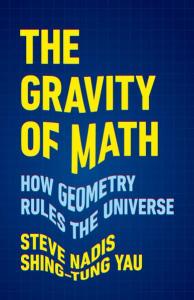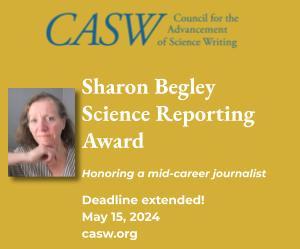THE GRAVITY OF MATH:
HOW GEOMETRY RULES THE UNIVERSE
Steve Nadis (NASW member) and Shing-Tung Yau
Basic Books, April 16, 2024
Hardcover, $32, eBook, $18.99
Hardcover ISBN-10: 1541604296, ISBN-13: 978-1541604292
eBook ASIN: B0CDWGVYT6
Nadis reports:
This is the fifth book I’ve written with the mathematician Shing-Tung Yau. Our collaboration began in the fall of 2006 after he was approached by a literary agent. We met in Yau’s Harvard office an hour after our first email exchange, and he was ready to start working on the book right away, whatever it was going to be about.
Things move more slowly in the publishing world, and our book on the mathematics of string theory, The Shape of Inner Space, didn’t come out until 2010. Shortly after its publication, an editor at an academic press asked Yau if he had any other book ideas. “How about gravity?” Yau said.
That idea hung there, in the back of my mind, for quite a while. We wrote three other books, A History in Sum, 150 Years Of Mathematics At Harvard (1825-1975), From the Great Wall to the Great Collider: China and the Quest to Uncover the Inner Workings of the Universe, and The Shape of a Life: One Mathematician’s Search for the Universe’s Hidden Geometry, the last of which came out in 2019. Later that year, when we contemplated our next project, I said, “What about gravity?”
The idea quickly took shape in my head. Yau is one of the world’s leading experts on the mathematics of general relativity, so it made sense that our book should be about just that. The challenge was that we would be writing for lay readers, not for graduate students in physics and math.
Here’s what we tried to get across in The Gravity of Math: first and foremost, to explain what Einstein’s theory of general relativity is all about; what his famous “field equations” (unveiled in November 1915) mean; and the mathematics they’re based on. During the 10-year struggle to devise his new theory, Einstein concluded that gravity is a consequence of geometry—the curvature of “spacetime”—rather than an attractive force. But he first had to learn about the geometric ideas of Bernhard Riemann formulated 60 years earlier.
Publication of the so-called Einstein equations was just the start of things. Mathematicians explored their implications, developing ideas about black holes, gravitational waves, and the Big Bang decades in advance of clear observational evidence. The exploration continues, with new papers on the mathematics of general relativity coming out practically every day.
Contact info:
- Steve Nadis: sjn.cambridge@nasw.org
- Book: The Gravity of Math: How Geometry Rules the Universe
- Publicist: Katherine Robertson, 212-364-0599, Katherine.Robertson@hbgusa.com
NASW members: will your book be published soon? Promote it by submitting your report for Advance Copy.
Tell your fellow NASW members how you came up with the idea for your book, developed a proposal, found an agent and publisher, funded and conducted research, and put the book together. Include what you wish you had known before you began working on your book, or had done differently.
See https://www.nasw.org/advance-copy-submission-guidelines.
View Advance Copy archives at https://www.nasw.org/member-article/advance-copy.
Thinking of writing a book? If you are a NASW member, you may access a list of more than 200 books and online resources to help you craft your book proposal, find an agent and funding sources, negotiate your contract, learn about self-publishing, publicize and market your book, and more at https://www.nasw.org/article/write-book.
View the recording of a recent Advance Copy Virtual Business Chat, A Primer for Authors on Book Publicity. NASW member login required.
View the recording of a recent Virtual Business Chat presented by NASW’s Freelance Committee and Advance Copy column Writing Wikipedia Profiles. NASW member login required.
Send book info and questions about book publishing to Lynne Lamberg, NASW book editor, llamberg@nasw.org.
Follow @LynneLamberg and @lynnelamberg.bsky.social for news about NASW authors, science/medical books, and writing.
Banner image adapted from original photo by Steve Nadis.



.png)

